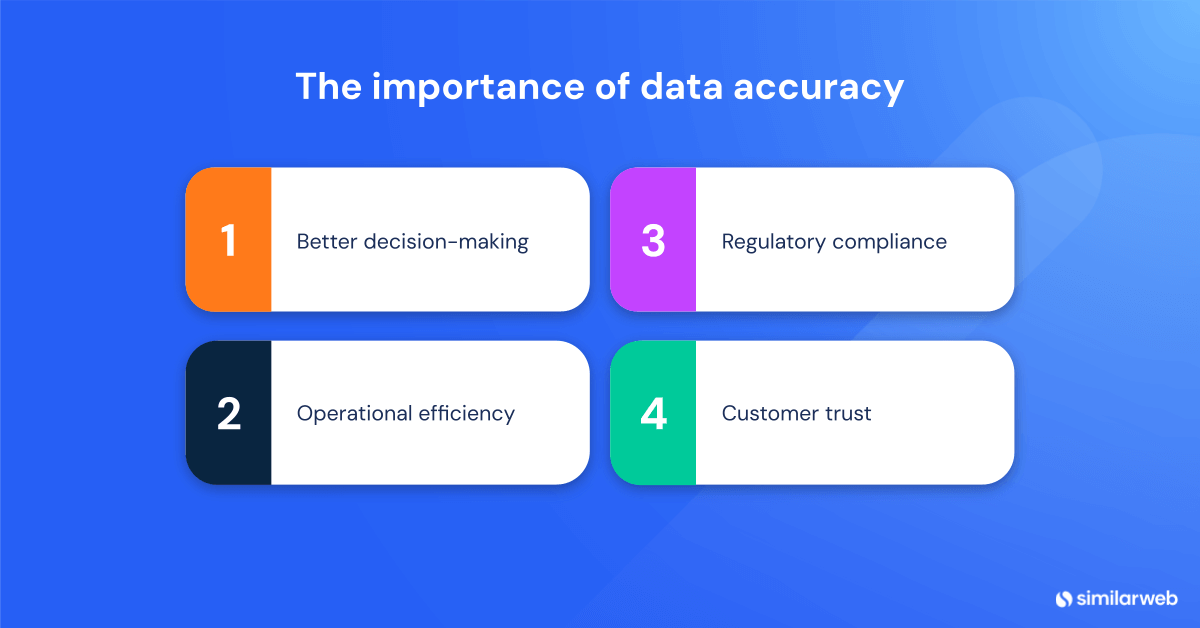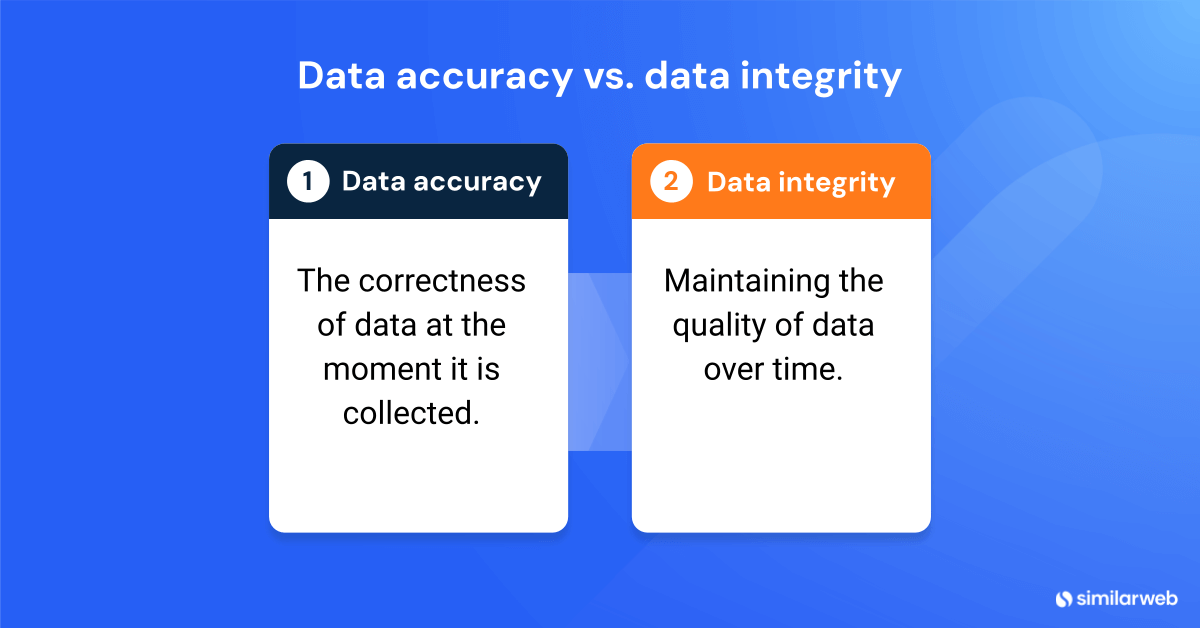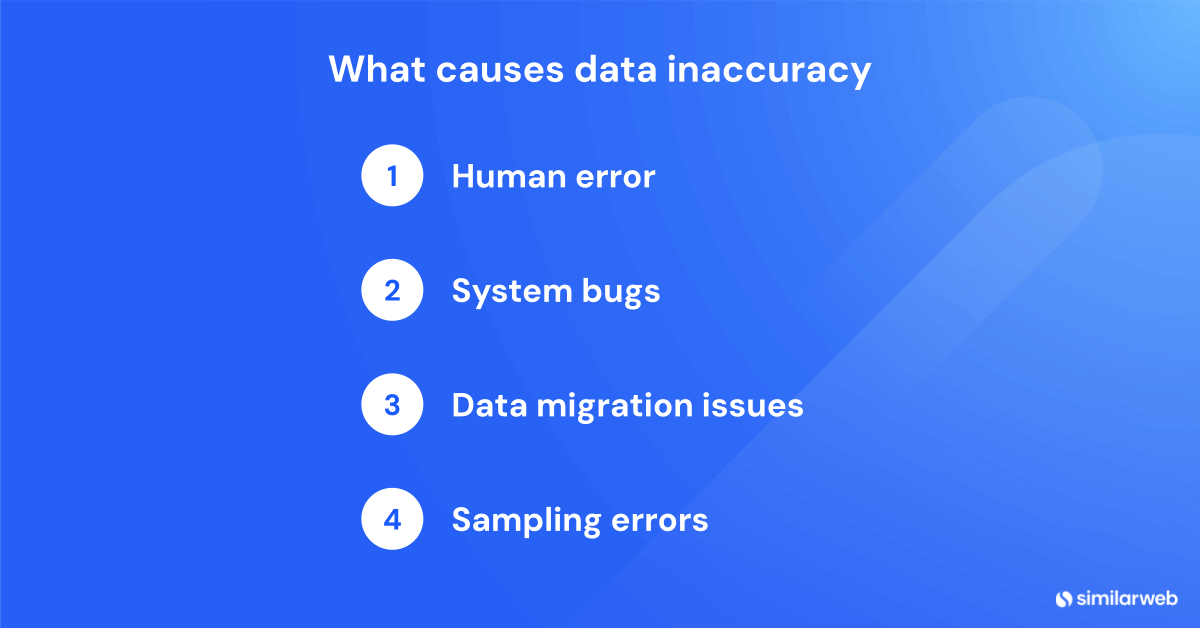Data Accuracy: Why Does It Matter And How To Achieve It?

In today’s data-driven business world, data accuracy isn’t just a nice-to-have—it’s a necessity. Whether you’re in healthcare, finance, technology, or any other industry, inaccurate data can lead to costly mistakes, poor decision-making, and even reputational damage. This guide will explain why data accuracy is crucial and how Data-as-a-Service can help you achieve it.
What is data accuracy?
Simply put, data accuracy refers to how well your data reflects real-world entities or events. It’s a cornerstone of any data-driven decision-making process. Imagine making business decisions based on faulty or outdated information—a recipe for disaster. Accurate data is free from errors, inconsistencies, and discrepancies, and it’s critical for any organization looking to optimize its performance.
Accurate data is a reliable source that can be compared against known benchmarks. Without it, you’re flying blind. It is also an integral factor of data quality that is key to timeliness, completeness, integrity, and reliability. What makes a difference between high-performing and poor-performing companies is how they handle their data accuracy. High data accuracy companies reduce overhead costs through streamlined operations and improved customer satisfaction.
Why is data accuracy important?
Let’s look at some key reasons why accurate data is essential.
Better decision-making
Accurate data paints a clearer picture of reality, allowing businesses to make better, more informed decisions. For example, a sales team using precise sales data can create highly targeted lists of prospects by leveraging precise traffic trends, demographics, and engagement metrics. By ensuring the accuracy of this data, sales teams avoid wasting time on unqualified leads and can focus their efforts on high-value accounts, leading to more efficient and effective sales processes.
Operational efficiency
When data is accurate, companies can operate more efficiently. For example, marketing teams must analyze thousands of keywords to maintain their competitive edge. Leveraging Similarweb’s keyword insights, they can efficiently track and analyze over 5 billion keywords across platforms like Google, Amazon, and YouTube. By using our API, they gain access to fresh data on critical metrics such as Keyword Difficulty, Search Intent, and mobile traffic patterns. This level of accuracy and granularity allows them to optimize campaigns in real-time, targeting the highest-converting keywords and adapting strategies swiftly to stay ahead of competitors, ensuring maximum efficiency and ROI.
Regulatory compliance
Many industries have strict data regulations. Maintaining accurate data ensures compliance and reduces the risk of legal penalties. For example, financial institutions using Similarweb’s investment intelligence data can monitor the digital footprint and performance of millions of companies globally. By accessing billions of data points daily with comprehensive granularity (daily, weekly, and monthly), these institutions can validate investment hypotheses and track key signals for earnings performance, ensuring they remain compliant with regulatory requirements. This precise data enables them to align their activities with industry standards and regulatory frameworks, reducing legal risks and maintaining a competitive edge.
Customer trust
Accurate data leads to fewer errors in customer service, boosting customer trust and satisfaction. In ecommerce, for instance, companies using Similarweb Shopper Intelligence solution can leverage accurate, cross-retail analytics to personalize the shopping experience. By analyzing top-performing categories, keyword trends, and consumer behavior with unparalleled granularity, ecommerce businesses can tailor their marketing campaigns and optimize product listings to match consumer demand precisely. This data-driven approach increases engagement, enhances customer loyalty, and improves conversion rates, building a strong foundation of trust with customers who receive relevant and timely offers based on their actual behavior and preferences.
Data accuracy vs. data integrity
While often used interchangeably, data accuracy and data integrity are not the same. Data accuracy refers to the correctness of data when it’s collected, while data integrity focuses on maintaining that quality over time. Consider accuracy the foundation—you can’t have integrity without accurate data. Both are crucial for reliable data management.
Common causes of data inaccuracy
Several factors can lead to inaccurate data. Understanding these can help you design better data management systems.
- Human error: Manual data entry often introduces typos and inconsistencies, which is especially problematic when the data is entered into multiple systems. Automation can help reduce these errors.
- System bugs: Outdated software, system bugs, or glitches can lead to inaccurate data outputs. A bug in a financial system’s software could cause transaction amounts to not compute. Regular maintenance is key.
- Data migration issues: Poor validation during data migration can lead to format differences and data loss. Always test and validate data before and after migration.
- Sampling errors: Inadequate controls can lead to discrepancies when data is passed between systems. Proper sampling and validation procedures are critical.
The consequences of inaccurate data: real-world impacts
Inaccurate data can have serious consequences, ranging from financial losses to reputational damage. Let’s explore some real-world examples to understand just how costly data inaccuracies can be:
1. Financial losses
One data entry error at Samsung led to a staggering $105 billion loss in value, showcasing the monumental risk of inaccuracies. This so-called “fat-finger” mistake—a simple, clumsy keypad entry—triggered a market disaster, demonstrating how one small error can have a massive financial impact.
2. Operational Inefficiencies
Incorrect data drains organizational resources, leading to duplicated work and reduced productivity. Teams may need to spend valuable time auditing and correcting mistakes, diverting resources away from more critical projects. This inefficiency can hinder an organization’s overall performance.
3. Regulatory Penalties
Inaccurate data submissions can lead to non-compliance with regulations, resulting in hefty fines and legal consequences. For instance, banks that fail to maintain accurate records risk severe penalties, damaging both their reputation and finances.
4. Reputational Damage
Uber’s underpayment of driver compensation, caused by an accounting error, is a prime example of how data inaccuracies can erode trust. This mistake damaged Uber’s relationship with drivers and tarnished its public image, highlighting how data errors can have long-lasting reputational impacts.
Measuring data accuracy
How can you ensure your data is accurate? Here are some best practices.
- Validation against trusted sources: Compare your data against reliable benchmarks to spot discrepancies
- Data profiling: Use software tools to identify patterns, trends, and outliers in your data.
- Error rate calculation: Calculate the percentage of errors in your dataset to focus efforts on improvement
- Sample testing and spot checks: Regularly test samples, especially when working with large datasets, to identify bigger issues in your dataset. Spot checks can help pick up inaccuracies that an automated process might miss
Best practices for ensuring data accuracy
To keep your data as accurate as possible, consider adopting these best practices:
- Consistent data entry protocols: Standardize data entry procedures and train employees to minimize errors.
- Automation tools: Automating data validation and cleansing processes can significantly reduce errors.
- Regular audits: Regularly audit your data to flag and correct inaccuracies. This should include enforcing internal checkpoints and reviews.
- Data governance framework: Establish policies and procedures for data entry, validation, and maintenance to ensure ongoing accuracy.
Adopting these best practices fosters a culture of accuracy within your organization, significantly reducing the chances of data errors. Your business can operate more efficiently, make smarter decisions, and—most importantly—build trust with customers and stakeholders. This trust empowers your company to leverage data as a driving force for growth and long-term success.
How Similarweb ensures data accuracy
Similarweb Data-as-a-Service solution provides insights that are both accurate and real-time. The offers the most accurate data, using a sound data methodology — including but not limited to:
Data collection
We created the industry’s most diversified data universe of digital signals, constructed of statistically representative datasets, including first-party direct measurement, anonymous behavioral data, public data, and partnerships that preserve variety across countries, industries, user groups, and devices.
Data synthesis
After collecting the data, we run a sophisticated algorithmic process to clean, match, synthesize, process, and blend inputs for data modeling.
Data modeling
Normalized data is then run through advanced machine learning calibration and predictive models to provide an accurate and consistent view of the digital world over time
Data delivery
This process generates powerful, ready-to-use insights delivered through our actionable platform or API to help you make better decisions and grow intelligently
Ensure data accuracy for future success
Accurate data isn’t just about avoiding mistakes—it’s about enabling smarter decisions, improving efficiency, and building customer trust. By following these best practices, you can ensure your data remains accurate and reliable, laying the groundwork for future success.
Start taking these steps today, and you’ll be better equipped to make informed decisions, optimize operations, and achieve long-term growth.
FAQs
How can I enable data accuracy in my organization?
Implementing validation routines, conducting regular audits, utilizing automated tools, and providing employee training on data handling standards are key steps to achieving and maintaining data accuracy.
How does inaccurate data impact business decisions?
Inaccurate data can lead to poor decision-making, resulting in operational inefficiencies, unnecessary financial losses, and even reputational damage to your business or brand.
What are some common sources of data inaccuracies?
Common sources of data inaccuracies include human error, system glitches, data migration issues, and sampling errors. Addressing these factors is crucial for maintaining high data accuracy.
How often should data accuracy be measured?
Data accuracy should be measured regularly, ideally at least once a quarter. Techniques like data profiling, error rate calculations, and sample testing against reputable sources can help ensure ongoing accuracy.
Why is data accuracy important for regulatory compliance?
Accurate data is essential for ensuring your company meets regulatory standards, helping to avoid legal issues, and protecting both your reputation and financial standing.
Wondering what Similarweb can do for you?
Here are two ways you can get started with Similarweb today!











